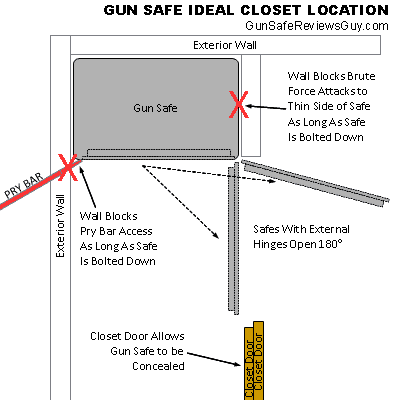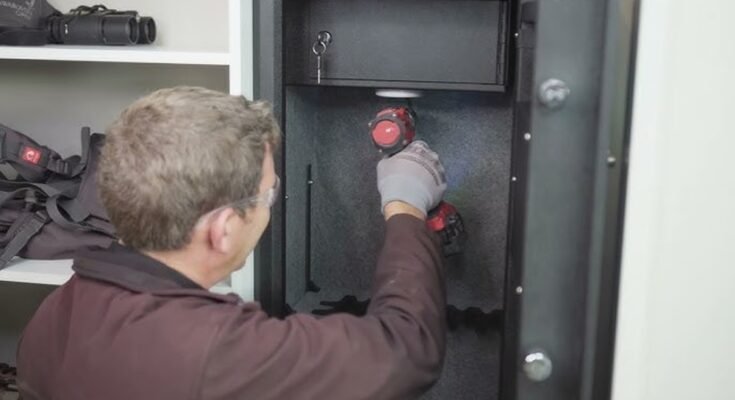If you own a pistol, keeping it safe and secure is a top priority. But how do you make sure your firearm stays protected from unauthorized access?
Installing a pistol safe is the best solution—and it’s easier than you might think. In this guide, you’ll discover simple, step-by-step instructions that anyone can follow. By the end, you’ll have the confidence to install your pistol safe quickly and correctly, giving you peace of mind every time you walk away.
Ready to protect what matters? Let’s get started.

Choosing The Right Pistol Safe
Choosing the right pistol safe is important for protecting your firearm. A good safe keeps your pistol secure and out of reach from others. It also helps protect the gun from damage and theft. Picking the best safe depends on your needs and where you plan to keep it. Understanding the types, size, and security features will guide your choice.
Types Of Pistol Safes
Pistol safes come in several types. Portable safes are small and easy to carry. They fit in bags or under seats. Biometric safes open with fingerprints for quick access. Electronic safes use keypads or digital locks. Mechanical safes have combination dials or keys. Each type offers different convenience and security levels.
Size And Capacity Considerations
Choose a size that fits your pistol and extra items. Some safes hold one gun, others fit multiple pistols. Check if you need space for magazines or documents. Make sure the safe fits the place where you want it. Compact safes work well for bedside or small spaces.
Security Features To Look For
Look for strong locks that resist tampering. Solid steel construction adds protection. Some safes have pry-resistant doors and hinges. Fire resistance adds safety in case of a fire. Alarm systems alert you if someone tries to open it. Choose features based on your security needs and budget.
Preparing For Installation
Preparing for the installation of a pistol safe is a key step. It sets the stage for a safe and secure setup. Careful planning helps avoid mistakes and saves time. This part covers the basics you must handle before starting the actual installation.
Selecting The Installation Location
Choose a spot that is hidden yet easy to reach. The location should be sturdy, like a solid wall or floor. Avoid areas with high moisture or extreme temperatures. Think about who else has access to this area. Privacy and security are top priorities here.
Gathering Necessary Tools
Collect all tools before you start. Common tools include a drill, screwdriver, measuring tape, and level. Check if the safe requires special bolts or anchors. Having everything ready prevents interruptions during installation. This also ensures you do the job right the first time.
Reading Manufacturer Instructions
Read the instructions carefully. Every safe model may have different steps. Follow the guide to avoid damage or voiding the warranty. Pay attention to any safety warnings. Understanding the instructions fully leads to a smoother installation process.
Mounting The Pistol Safe
Mounting the pistol safe is a crucial step for security and accessibility. A properly mounted safe stays firmly in place and protects your firearm. This process involves marking drill points, drilling holes carefully, and securing the safe to the surface. Follow these steps for a strong and safe installation.
Marking Drill Points
Place the pistol safe where you want to mount it. Use a pencil to mark the holes through the safe’s mounting slots. Double-check the marks for accuracy. Clear, precise marks make drilling easier and safer.
Drilling Holes Safely
Choose a drill bit that matches the size of the mounting screws. Wear safety glasses to protect your eyes from dust and debris. Drill slowly and steadily on the marked points. Avoid rushing to prevent damage to the surface or the safe.
Securing The Safe To The Surface
Align the safe with the drilled holes. Insert the mounting screws through the safe and into the holes. Tighten each screw firmly using a screwdriver or drill. Check if the safe is stable and does not move. A secure safe keeps your pistol protected and ready.

Setting Up Lock Mechanisms
Setting up the lock mechanisms is a key step in installing a pistol safe. The lock keeps your firearm secure and only accessible to you. This step requires careful attention to ensure safety and ease of use. Different types of locks need different setup methods. Follow the instructions for your specific lock type to avoid problems.
Programming Electronic Locks
Electronic locks need programming before use. Start by opening the safe with the factory code. Enter the programming mode as described in the manual. Set your new personal code carefully. Use numbers easy to remember but hard to guess. Confirm the new code by entering it twice. Some locks allow adding multiple user codes. Save all changes and exit programming mode. Test the new code to check it works properly.
Using Mechanical Lock Combinations
Mechanical locks require setting a combination code. Turn the dial to clear previous settings. Follow the guide to choose a new combination. Write the numbers down in the correct order. Practice opening the safe with the new code. Avoid sharing the combination with others. Mechanical locks do not need batteries or power. Keep the combination secret for safety.
Testing Lock Functionality
After setting the lock, test it several times. Open and close the safe using your new code. Check that the lock secures tightly every time. Make sure the safe opens quickly without errors. Test the lock in different lighting conditions. Confirm the lock operates quietly and smoothly. Fix any issues before storing your pistol inside. Testing ensures your firearm stays protected at all times.
Maintaining Your Pistol Safe
Maintaining your pistol safe ensures it stays reliable and secure. Regular care prevents rust, dust, and mechanical problems. A well-kept safe protects your firearm and keeps it ready for use.
Regular Cleaning Tips
Clean the safe’s exterior with a soft cloth. Avoid harsh chemicals that can damage the finish. Use a vacuum or brush to remove dust inside the safe. Keep the interior dry to prevent rust and mold. Clean your pistol safe monthly to maintain its condition.
Checking Lock And Hinges
Test the lock regularly to ensure smooth operation. Lubricate hinges and locking mechanisms with light oil. Avoid over-lubricating, which can attract dirt. Tighten loose screws to keep parts secure. Check for signs of wear or damage often.
Upgrading Security Over Time
Consider upgrading your safe’s lock for better security. Electronic locks can replace manual ones for ease of use. Add additional bolts or reinforcement if needed. Keep your safe in a hidden or hard-to-reach place. Update your security measures as technology improves.

Frequently Asked Questions
How Do I Choose The Best Location For A Pistol Safe?
Select a discreet, secure spot that’s easy to access. Avoid places prone to moisture or extreme temperatures. Common locations include closets, under beds, or inside cabinets. Ensure the spot is hidden from children and unauthorized users for maximum safety.
What Tools Are Needed To Install A Pistol Safe?
Basic tools include a drill, screwdriver, measuring tape, and a pencil. Anchoring bolts or screws usually come with the safe. Using a stud finder is helpful for wall-mounted safes. Always follow the manufacturer’s instructions for specific tool requirements.
Can I Install A Pistol Safe Without Professional Help?
Yes, many pistol safes are designed for DIY installation. Follow the included instructions carefully for proper mounting. Ensure the safe is securely anchored to prevent theft. If unsure, consider consulting a professional for added security and peace of mind.
How Do I Secure A Pistol Safe To Prevent Theft?
Anchor the safe to a solid surface like a wall stud or floor. Use heavy-duty bolts or screws included with the safe. Choose a location that’s hard to detect or access. Regularly check the anchors for looseness or damage to maintain security.
Conclusion
Installing a pistol safe keeps your firearm secure and out of reach. Choose a strong location and use proper tools. Follow each step carefully to ensure safety. Regularly check the safe’s lock and mounting. This small effort protects your family and peace of mind.
Safe storage matters for every gun owner. Stay responsible, stay safe.



